 |
|
|
|
|
COVID-19 Edition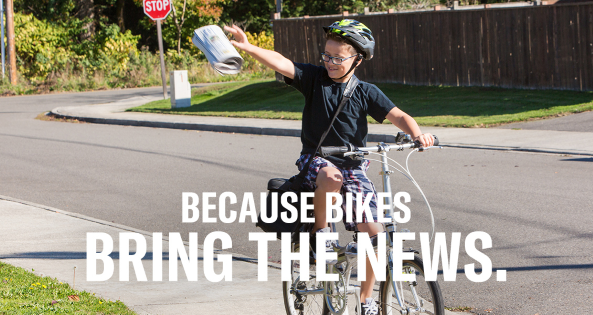 Photo Courtesy USA Cycling
I think that COVID-19 says it all!
As you know, all our March and April activities have been cancelled. (We did manage to hold a Board of Directors and General Membership meeting on 3/11, before the shelter-in-place order was given).
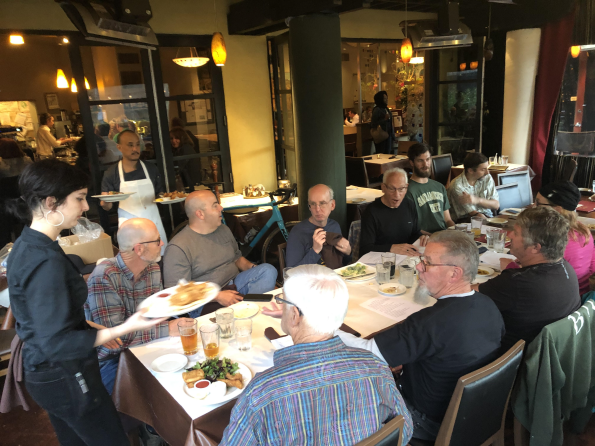
March General Membership and Board Meeting. Photo courtesy John Roberts.
May is “right around the corner.” Hopefully we will be back to biking with RLaG on 5/3, our Gala ride on 5/9 at Crockett Hills, and our bi-monthly Board meeting on Wednesday, 5/13.
To make up for lost riding time, hopefully we can get some POP-UP rides scheduled. But as always we need *your* help! Since many of our newer members are novice riders, we plan to schedule novice pop-up rides and novice skills classes starting in May. All our activities are posted and announced on Meetup.
As you probably know, to service bike deliveries, local bike shops have been given permission to remain open. Mike's Bikes, The Pedaler, Trek Store in Berkeley among others are known to be open.
Want to help our local communities? Consider a donation to FeedER. Our goal is to feed the emergency department and the ICU in five East Bay hospitals two meals a day, at a cost of $13k a day. Help us meet that goal.
Also, consider A donation to your local foodbank. Mine is the Alameda County Community Foodbank.
-- Mike
BTCEB via Facebook

Finally, if you want to hear about other last-minute news, such as demo rides, and volunteering opportunities, "like" and follow BTCEB's Facebook Notification Page, and also request to join BTCEB's Facebook Discussion Group.
|
|
|
|
|
| **************************************************************************************************
REPORTS
Tentative Gala Ride Dates and Locations
by Mike Udkow
Here are the expected ride dates and locations for the club gala rides for 2020:
- May 9 - Crockett Hills EBRP
- Jun 13 - Wildcat/Tilden EBRP
- Jul 12 (Sunday) - China Camp
- Aug 8 - Joaquin Miller Park (Oakland)
- Sep 26 - Fernandez Ranch (JMLT)
- Oct 11 - Crockett Hills EBRP
- Nov 14 - Rockville
- Dec 12 - Deer Park
As always look for them to appear on the BTCEB Meetup Events page and here in The Buzz as the dates approach and the ride details firm up.
BTCEB Membership Drive
by Mike Udkow While membership on our Meetup site continues to grow to over 3,900 followers, membership in the BTCEB, your mountain biking organization, has been lagging.
To grow, to survive, and to represent the mountain biking community, we need your support. Your membership dues support our Gala rides and our RLaG program, pays for our insurance, helps to support NorCal High School MTBing and supports trail work at China Camp, Rockville, Fernandez and Crockett. We are hard at work developing the JMP Pump Track. Our Board of Directors meets bi-monthly to discuss all topics relevant to local mountain biking.
Membership levels start at $30, with a $15 student/hardship level. Lifetime membership is $500.
Aside from the dues, we truly need and value your membership.
Please join or renew today at www.btceb.orgSee you on the trails!
**************************************************************************************************
From the Dusty Trail . . .
Health is a Community Effort
By John Roberts
Camp Tamarancho photo courtesy Jamuel Starkey. 1) Keep your distance (fire road is better than single track, and ride independently)
2) Ride extremely slow when encountering others
3) Take no risks as healthcare facilities are full (wear mask or have a droplet containment plan)
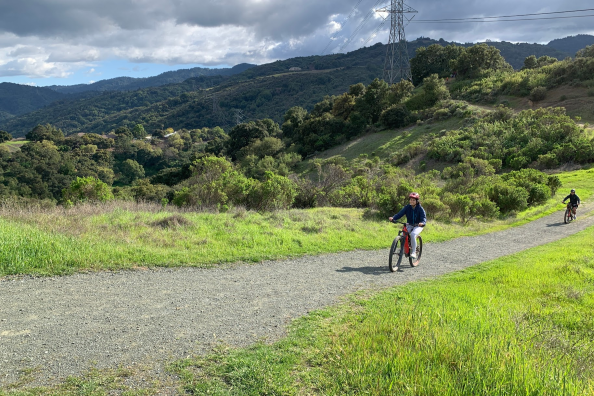
Archive Photo
Rider Dan was upset. He had worked for weeks from home, just in order to keep any possible virus from spreading. It was at the local park where he took his chance to finally go outside. On a tight singletrack, he stopped and pulled to one side as another rider approached. The other person rode up, did not slow down, and as he passed said: “hello”.
Was Rider Dan justified in being upset? There may be a chance all that quarantine time went to waste in an instant. The other rider did not slow, and he spoke at a close proximity.
Riding past others should be done slowly. Think of what happens when riding on a dusty day. Dust goes everywhere. The faster you go, the more your draft creates turbulent air currents that carry dust (or tiny fog droplets), to others.

Camp Tamarancho photo courtesy Jamuel Starkey.
In all honesty, health professionals are still trying to figure out exactly how the latest virus transmits. The CDC suggests contagion through objects is not the primary concern. Person-to-person interaction is.
Exercise is good but can be a risk to others. It increases blood flow. This is a good thing. It can also increase the amount of snot and other fluids in the throat that require the occasional cough. It is Spring and there are plenty of allergens in the air too. Which all can bring about coughing and sneezing.
Plenty of research has been done on the human aeration of droplets. The article from the link below cites many sources, and has easy to understand instructional pics.
On a positive note, being outdoors is very healthy. More on point to staying healthy, here is a short paraphrase of some of findings regarding droplet transmission:
Sneezing may produce 40,000 droplets at speeds of up to 100 m/s, coughing may produce up to 3,000, about the same as talking for five minutes.
Source: Natural Ventilation for Infection Control in Health, World Health Organization; 2009.
Stay home if you are sick. This applies even if you do not have the novel corona virus (COVID-19). At this time, we may want to diminish the likelihood of the spread of any disease. Folks that catch COVID-19 may feel better if they do not have other diseases to fight too, such as the flu.
Even if you are not sick, take precautions as if you were. COVID-19 can be contagious even before symptoms appear. If you plan to chat with a friend, or to just say “hi” to other park users on the trail, consider using a cloth mouth cover, such as a surgical mask or even a bandana. If you do not wear one, keep quiet and plan on using hand gestures, such as a wave, for a non-verbal hello.
Coughing and sneezing can be involuntary. It's a prime reason for social distancing. Regardless, try to face away from others when coughing. If you do not have a mouth cover, try to cough or sneeze by first raising your collar over your nose, and coughing down into your shirt.
The goal is to keep disease transmission rates low. This will keep health facilities from becoming saturated. It also gives hope COVID-19 will pass. And particularly during these times, stay safe in all you do.
Sudden Oak Death: A Brief Overview and a Call to Action for Citizen Scientists
by Yvette Skinner
Sudden Oak Death (SOD) is the common name for a plant disease that is devastating the native oak trees along the California coastal ranges. Although the pathogen that causes SOD can also cause disease in other plants this article is focused on the effects on oak species as well as the Tanoak, which is not part of the oaks’ genetic family, the genus Quercus. Oak tree species of concern include the California coastal live oak, California black oak, Shreve oak, and Canyon live oak. This article will present a brief overview of SOD’s cause, how it spreads, and what can be done to help in the battle against this potent tree disease. At the end readers will find several links to web pages on the topic which can provide references and additional reading.
Sudden Oak Death is caused by an invasive fungus, Phytophthora ramorum, which is believed to have been accidentally introduced more than 20 years ago from imported ornamental plants. Phytophthora translates to English as “plant killer” and this disease is a virulent killer of oak trees with mortality rates as high as 100%. Once the trees are weakened by SOD they are susceptible to increased attacks by other pests such as bark beetles which hasten the tree’s demise. A classic symptom of the disease are oozing “cankers” on the trunks which look like dark sap seeping from the bark.

SOD does not spread uniformly but rather occurs in many clusters or “hot spots” which extend as far north as Curry County in southern Oregon to the extreme southern border of Monterey County. The pathogen thrives in cool, moist climates which inhibits the disease from spreading to the hot, dry central valley.
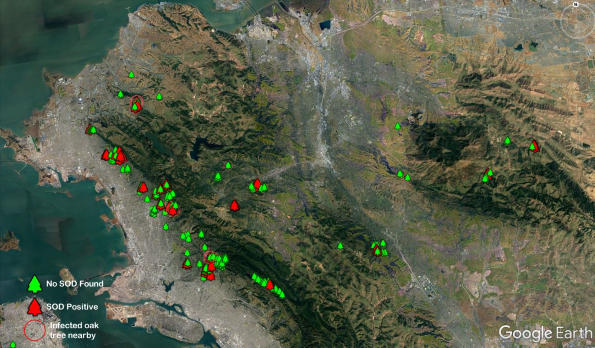
In fact, in the East Bay counties of Contra Costa and Alameda the disease can be found along the Front Range but the number of infected trees drops precipitously in the eastern half of these same counties due to slightly hotter and drier microclimates. Unfortunately the total extent of the infection has not been quantified as much of the forests in vulnerable areas have not yet been tested.
The California Bay Laurel is key vector for the disease. Bay trees will become infected but typically do not die. The pathogen can reproduce while living on the Bay trees and release their spores. Spores are spread through wind and water but will not travel far from the infected tree, often 30 yards or less. Outbreaks of SOD are higher in wet years with above average rainfall. Bay trees will become infected in an area before the oaks therefore scientists monitoring the spread of the disease have recruited citizen scientists to sample Bay trees and collect leaves which show signs of infection to be tested.
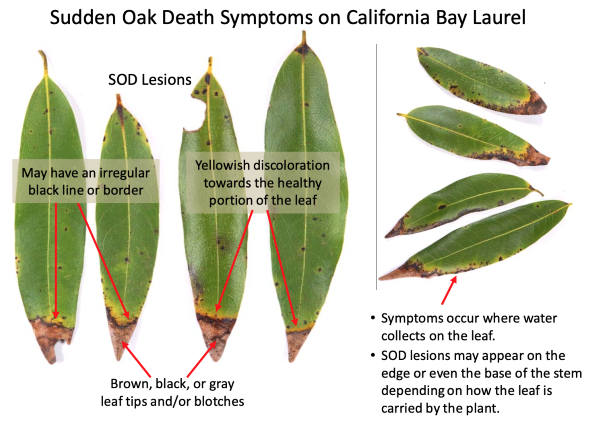
SOD Blitz is the name given to the annual SOD tree surveys held each Spring when the temperature and moisture conditions are ideal for the spreading of the pathogen. Volunteers are trained to spot the symptoms of infected Bay trees and are given envelopes to collect leaves from trees suspected of SOD infection. The leaves are labelled with the tree’s GPS coordinates to pinpoint the tree’s location. Volunteers turn in their packets of envelopes and the leaves are sent to be tested at the UC Berkeley laboratories because the symptoms of SOD can appear similar to other unrelated tree diseases. The results are posted by October on the SODMAP web page and app (available on Apple and Google Play stores). In the 2019 SOD Blitz, the first infected trees in Del Norte County were identified. Previously the closest infection “hot spots” in that area were southern Curry County (Oregon) and southern Humboldt County.
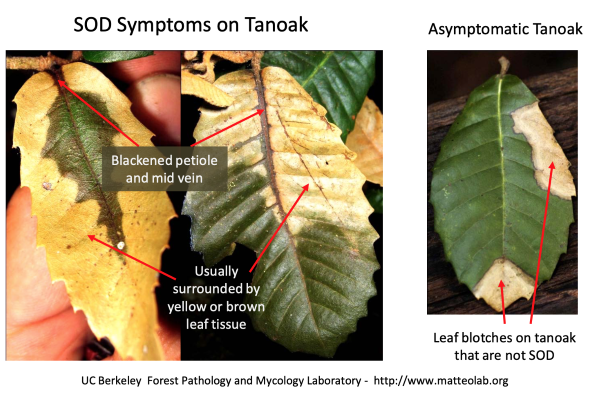
Identification of infected Bay trees provides land managers information to assess the risk of nearby oaks becoming infected. It may be necessary to cut down Bay trees in proximity to an oak tree to prevent the spread of infection. Best Management Practices and Phosphite treatments have been shown to prevent the spread of SOD on individual trees using in landscaping, however, these methods are not practical solutions to save an entire forest. It is possible to prioritize and maintain healthy trees in a landscaped environment. Consultation with a licensed arborist is recommended for these situations. Unfortunately, by the time an oak tree is showing symptoms of SOD such as the oozing cankers and die-back the tree will almost certainly die.
This April the SOD Blitz is still scheduled to take place in mid-April, however, significant changes have been made in light of the current COVID-19 outbreak. Instead of classroom training, volunteers will be trained using online videos. A limited number of leaf collection packets will be available this year. The current “Shelter at Home” order will drastically limit the scope of this year’s Blitz. Public health and safety take priority. Nevertheless, the public’s support of SOD Blitzes in the past decade have been strong. Last year’s Blitz was the largest to date. More than 600 participants surveyed over 16,000 trees. Although this year’s Blitz will be small by comparison, readers are encouraged to watch the online videos, learn about SOD, and consider joining the 2021 Blitz.
These Blitzs provide an opportunity for mountain bikers to take action to protect the forests they love to ride in. Many of the parks and open spaces in the East and North Bay Area frequented by mountain bikers have seen little to no testing: Joaquin Miller Park, Crockett Hills, Fernandez Ranch, Rockville Regional Park, China Camp State Park, Skyline Wilderness Park and more. In the South Bay the rates of testing and infection are higher with SOD-positive trees stretching from Redwood City to Gilroy and south to Santa Cruz.
Download the SODMAP app, to see where infected trees have been identified. If sufficient data is available the app can estimate the level of risk for oak tree infection using the smartphone’s current location (GPS coordinates).
More information on SOD can be found here.
Let's Clear the Drains!
by John Roberts
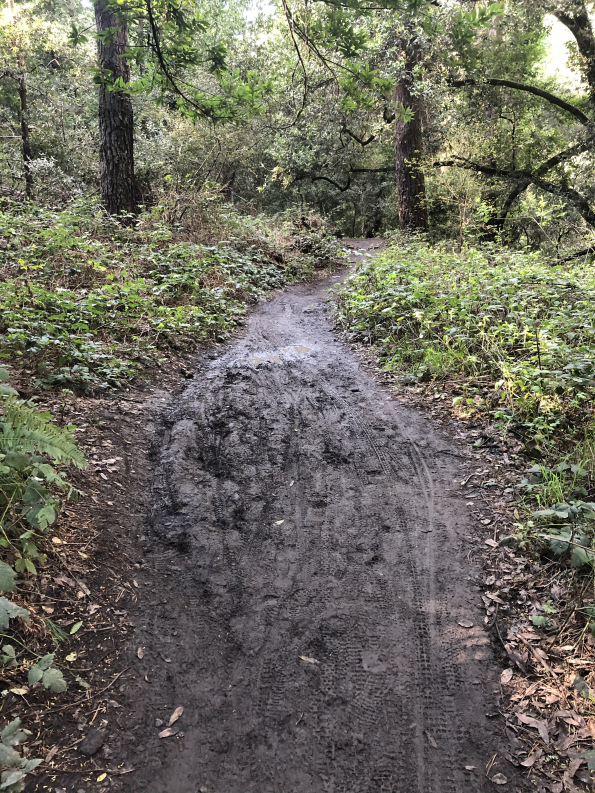 Sloppy conditions on Sinawik Trail
On a whim, I rode Joaquin Miller Park yesterday as the sun was setting. There were plenty of puddles and mud on Sinawik Trail and in parts of other trails all the way to the top of the park. Same day at Bishop's Walk trail
Yet, on Bishop’s Walk trail, there were no puddles, not even mud. It was like riding a trail that had a dry carpet on top. About half the waterbars I put there at the end of the season last year have smoothed out. As their life runs out, these water bars will start to resemble more subtle dips than bars.
When I did the work, there were no less than six major puddles and mud was all over the bottom half of Bishop’s Walk. Water was also running down the trail creating deep ruts. Some trail users were going around a few of the puddles, and widening the trail, but these issues are no longer the case.
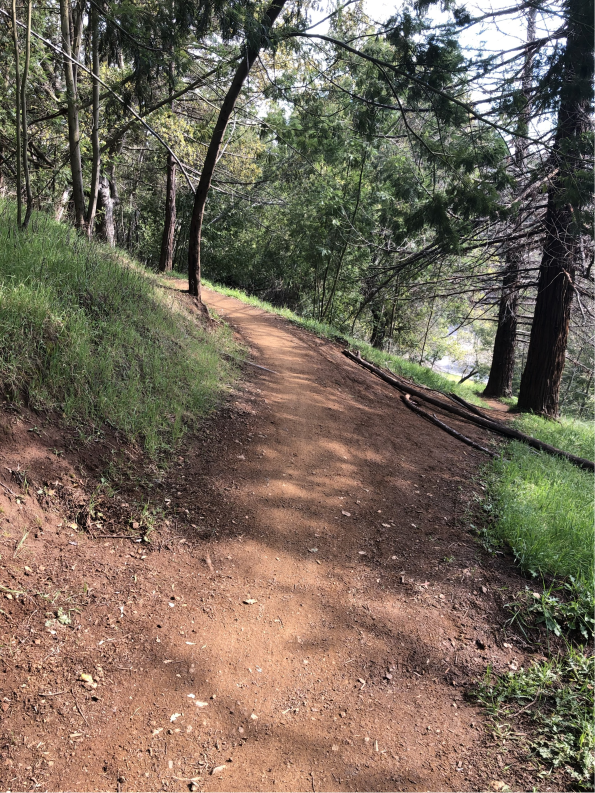 Bishop's Walk trail off camber turnBy the way, the infamous off camber turn on Bishops Walk trail, in my opinion, serves as a great speed control, much like in other parts of JMP where half-fallen trees are left alone for this same purpose. My thought is its better to focus on drainage, as a dry trail is more fun and sustainable than a wet and muddy one. This off camber slight left turn drains better than anything.
Candidate trails for clearing their drainage of duff include: creekside Sinawik, Sunset just southeast of the meadow, eastern Big Trees, and southern Bayview. This is in addition to a serious Cinderella work project under consideration. The end of the rain season is arguably the best time to do drain trailwork. So, please be on the lookout for future trailwork opportunities on BTCEB’s Meetup page. In the Novel Time of COVID-19:
Patrolling Joaquin Miller Park
by Buzz Hines
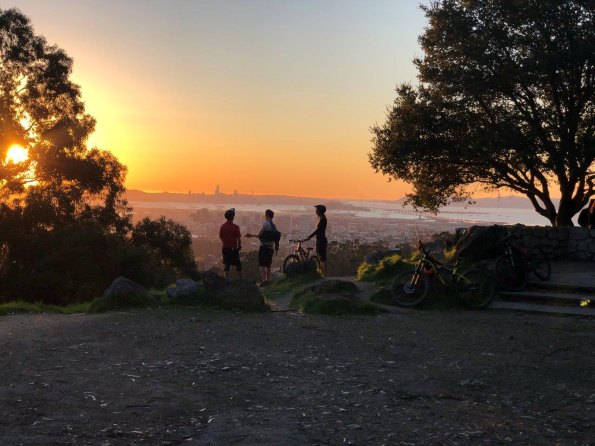 Lookout Point at Joaquin Miller Park
What a difference a month makes!
After taking a nice photo while on patrol in Joaquin Miller Park in early February of three riders framed by the setting sun from Lookout Point off Sanborn Drive, I was asked to do a short article about the Oakland Bike Patrol (OBP) for The Buzz. Even with the extra day in February this year, I still missed the deadline, and so resolved to write the piece for this month’s newsletter. How our lives, and those things we thought of as “normal,” have changed in the meantime.
Parks like Joaquin Miller and nearby East Bay Regional Park lands are currently providing a needed respite to the community as we all shelter in place, and do our collective best to stop the spread of COVID-19. But how best to employ social distancing techniques in a park like Joaquin Miller, where single track abounds and the widest trails are at most six to eight feet across? There are no easy answers for those walking the trails (alone or with their dogs), or for those of us on our bikes.
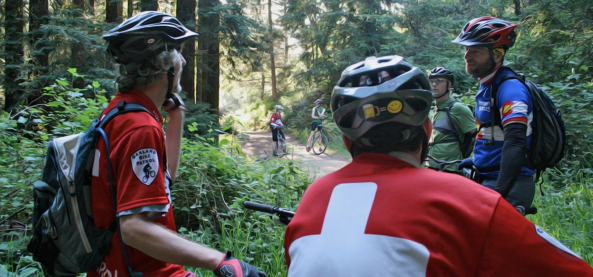
Photo courtesy OBP website
What we can do is to follow the current local and state guidelines, and walk or cycle to the trailhead. For cyclists, our bells and our voices are now critical to keeping safe distance, and we also need to think about what trails we choose to ride, the time of day we choose to ride, and when and where to dismount to let other riders or walkers pass. We also need to “leave no trace,” and carry out our trash. For hikers, keep your group size to a minimum, and if your group numbers two or more, move to the same side of the trail when encountering other walkers or cyclists.
Fortunately, our local parks have not seen the huge numbers of visitors seen in Marin County and some other park lands (see the photo below taken in mid-March from the same location at The Lookout), but there are crowds nonetheless.
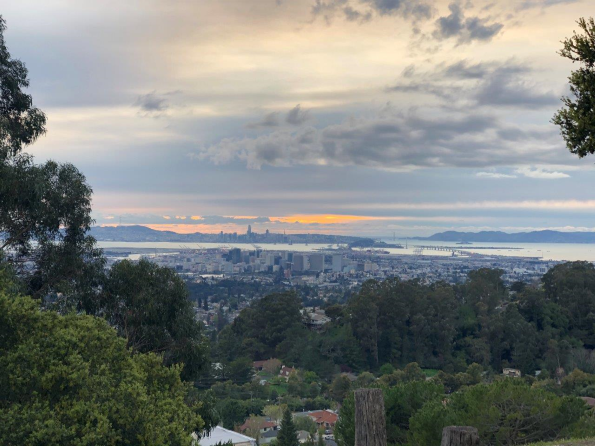
The OBP has helped deal with the influx of new trail users and visitors, by educating folks on proper trail etiquette and providing directions where needed, being the park’s “eyes and ears” to report conditions in the park that may need attention, and assisting with mechanical issues or rendering medical aid as First Responders. On that last point, we urge you to be careful out there as this is no time to have to go to the Emergency Room!
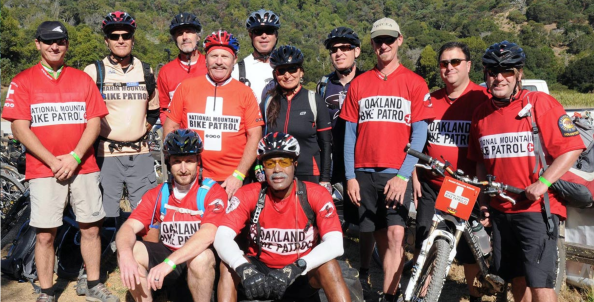
Photo courtesy OBP website
Members of the OBP, which currently numbers sixteen, will continue to volunteer their time patrolling Joaquin Miller and other nearby City of Oakland parks and trails during the crisis and once it passes and it is safe to interact socially. You will see us out there in our red shirts and official Oakland Police Department (OPD) badges.
For more detail on all that we do, the OBP website describes the the organization as follows:
The Oakland Bike Patrol consists of volunteers partnering with land managers and the Oakland Police Department to assist, educate, and inform trail users in order to enhance their recreational experience at Joaquin Miller & Dimond Parks. OBP is dedicated to preserving and maintaining trail opportunities for mountain bikers in city parks. Volunteers provide maps and directions, monitor and report adverse trail conditions, encourage responsible riding, and assist in medical and mechanical emergencies. Best of all you get to ride some of the best east bay trails, serve your community, meet great people, and help ensure continued trail access.
In coordination with BTCEB, the OBP started in the late 1990s in response to park access and trail stewardship issues. We have fluctuated in size over the years, and through several City administrations and changes over time in OPD leadership, we have maintained a close working relationship with City officials and the OPD. To this day the Patrol provides on the ground advocacy for continued access to single track in Joaquin Miller Park, and we represent the cycling community and help ensure that the non-cycling community have a positive perception of mountain bike riders.  Like what you hear? Want to get involved? Please check out the Oakland Bike Patrol website. We welcome your questions and possible interest in joining the OPD.
See you on the trails, and stay safe out there!
------ Reminder: As a BTCEB member, you can receive a 10 percent or higher discount for parts at many of the bike shops in the East Bay. You just have to ask. Thank you to the many bike shop sponsors for your support!
****************************************************************************************** |
|
|
|
|
|
ABOUT BTCEB
BTCEB is a one-stop shop. We defend access rights. We lead volunteers to build sustainable trails and repair historic trails. We host social rides. We teach underprivileged kids to ride. We fund youth mountain bike race teams. The list goes on because as riders we can do more together than individually. If you have not already, please consider joining us as a member. Many bike shops in the East Bay grant a 10% discount on bike parts to BTCEB Membership Card holders. It is just another benefit of joining BTCEB. Thank you to all the East Bay bike shops that support our efforts both on and off the trails!
CONTACT US
Do you have a good ride story, trailwork report, or other bike trail news? Tell us about it. Please send a paragraph with 150 words or less with a pic (under 10MB please) and/or link telling us about trailwork, rides, events, or any good mountain bike effort to bring our community together, etc. Please send via email to our editor Jamuel Starkey (with pictures if possible) at: buzz@btceb.org
BTCEB BOARD MEMBERS Mike Udkow, Presidentinfo@btceb.orgJon Running, Membership Coordinatormembership@btceb.orgYvette Skinner, Vice President
Dan McAvoy, Secretary
Alan Enrici, Treasurer
Henry Mitchell, Trails Coordinator
Dave Wolden, Director of Youth Programs (YMBA)Amy Arcus, Director of Women's Programs
Tom Gandesbery, Member-at-Large
Tom Holub, IT Chair |
|
|
|
|
|
|
|